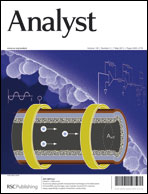A novel sensing strategy for the detection of Staphylococcus aureus DNA by using a graphene oxide-based fluorescent probe
Abstract
A novel sensing strategy for sequence-specific recognition of Staphylococcus aureus (S. aureus) DNA was designed based on the DNA hybridization between


 Please wait while we load your content...
Please wait while we load your content...